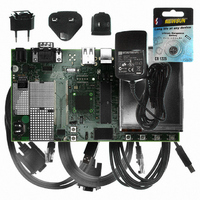AT91SAM9G10-EK Atmel, AT91SAM9G10-EK Datasheet - Page 127

AT91SAM9G10-EK
Manufacturer Part Number
AT91SAM9G10-EK
Description
KIT DEV FOR SAM9G10 ARM
Manufacturer
Atmel
Type
MCUr
Specifications of AT91SAM9G10-EK
Contents
Board, Cables, Power Supply
Silicon Manufacturer
Atmel
Core Architecture
AVR
Kit Contents
Board
Svhc
No SVHC (15-Dec-2010)
Mcu Supported Families
AT91SAM9G10, ARM926EJ-S
Tool / Board Applications
Microcontroller
Rohs Compliant
Yes
For Use With/related Products
*
Lead Free Status / RoHS Status
Contains lead / RoHS non-compliant
- Current page: 127 of 730
- Download datasheet (12Mb)
20. Bus Matrix (MATRIX)
20.1
20.2
20.3
20.3.1
20.3.2
20.3.3
6462A–ATARM–03-Jun-09
Description
Memory Mapping
Special Bus Granting Techniques
No Default Master
Last Access Master
Fixed Default Master
The Bus Matrix implements a multi-layer AHB, based on AHB-Lite protocol, that enables parallel
access paths between multiple AHB masters and slaves in a system, thus increasing the overall
bandwidth. The Bus Matrix interconnects 5 AHB Masters to 5 AHB Slaves. The Bus Matrix user
interface is compliant with the ARM Advanced Peripheral Bus and provides 5 Special Function
Registers (MATRIX_SFR) that allow the Bus Matrix to support application-specific features.
The Bus Matrix provides one decoder for every AHB Master Interface. The decoder offers each
AHB Master several memory mappings. Depending on the product, each memory area may be
assigned to several slaves. Booting at the same address while using different AHB slaves (i.e.,
external RAM, internal ROM, internal Flash, etc.) becomes possible.
The Bus Matrix user interface provides a Master Configuration Register (MATRIX_MCFG) that
performs a remap action for every master independently.
The Bus Matrix provides some speculative bus granting techniques in order to anticipate access
requests from some masters. This technique reduces latency at first accesses. The bus granting
technique sets a default master for every slave. At the end of the current access, if no other
request is pending, the slave remains connected to its associated default master. A slave can be
associated with three kinds of default masters; no default master, last access master and fixed
default master.
At the end of current access, if no other request is pending, the slave is disconnected from all
masters. No Default Master suits low-power mode.
At the end of current access, if no other request is pending, the slave remains connected to the
last master that performs an access request.
At the end of current access, if no other request is pending, the slave remains connected to its
fixed default master. Unlike last access master, the fixed master does not change unless the
user changes it by a software action.
To change from one kind of default master to another, the Bus Matrix user interface provides 5
Slave Configuration Registers, one for each slave, that set default master for each slave. The
Slave Configuration Register contains two fields; DEFMSTR_TYPE and FIXED_DEFMSTR. The
2-bit DEFMSTR_TYPE flag selects the default master type (no default, last access master, fixed
default master) whereas the 3-bit FIXED_DEFMSTR flag selects a fixed default master provided
that DEFMSTR_TYPE is set to a fixed default master. See
face” on page
129.
“Bus Matrix (MATRIX) User Inter-
AT91SAM9G10
127
Related parts for AT91SAM9G10-EK
Image
Part Number
Description
Manufacturer
Datasheet
Request
R

Part Number:
Description:
MCU, MPU & DSP Development Tools KICKSTART KIT FOR AT91SAM9 PLUS
Manufacturer:
IAR Systems

Part Number:
Description:
DEV KIT FOR AVR/AVR32
Manufacturer:
Atmel
Datasheet:

Part Number:
Description:
INTERVAL AND WIPE/WASH WIPER CONTROL IC WITH DELAY
Manufacturer:
ATMEL Corporation
Datasheet:

Part Number:
Description:
Low-Voltage Voice-Switched IC for Hands-Free Operation
Manufacturer:
ATMEL Corporation
Datasheet:

Part Number:
Description:
MONOLITHIC INTEGRATED FEATUREPHONE CIRCUIT
Manufacturer:
ATMEL Corporation
Datasheet:

Part Number:
Description:
AM-FM Receiver IC U4255BM-M
Manufacturer:
ATMEL Corporation
Datasheet:

Part Number:
Description:
Monolithic Integrated Feature Phone Circuit
Manufacturer:
ATMEL Corporation
Datasheet:

Part Number:
Description:
Multistandard Video-IF and Quasi Parallel Sound Processing
Manufacturer:
ATMEL Corporation
Datasheet:

Part Number:
Description:
High-performance EE PLD
Manufacturer:
ATMEL Corporation
Datasheet:

Part Number:
Description:
8-bit Flash Microcontroller
Manufacturer:
ATMEL Corporation
Datasheet:

Part Number:
Description:
2-Wire Serial EEPROM
Manufacturer:
ATMEL Corporation
Datasheet:










